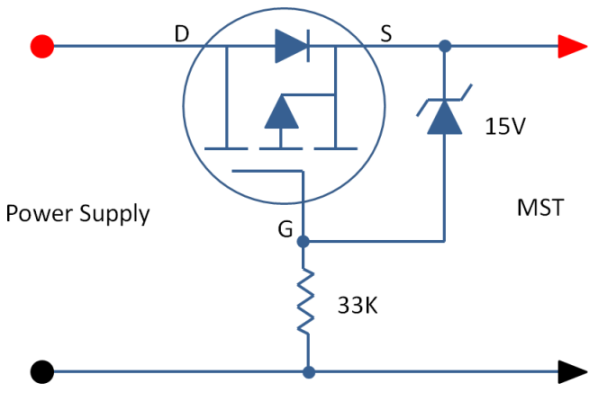I have been searching EESE and Google for several weeks now for a solution to this problem, and while I found some proposals that seemed promising, the real-world implementation fell short of expectations.
I have a voltage regulator on a board with 10 μF input capacitance to help protect against brownout conditions. I have a fuse in series with the power supply sized to 125 mA for various reasons, and just to be clear, I have not found any slow-blow versions that meet my requirements. The power supply can be anything from 5 volts to 15 volts DC, most likely a lead-acid battery. When the battery is first connected I see an inrush current with a peak of approximately 8 amps over 8 μs, which very quickly blows the 125 mA fuse. Okay, so I need to limit the inrush current. No big deal, right?
I tried a number of different options, but this is the one that seemed most promising:
R1 and R2 form a voltage divider that limits the Vgs to prevent damage to the MOSFET, and along with the capacitor form an RC delay that allows the FET Vgs to increase more slowly, keeping the FET in its ohmic region for a longer amount of time. Makes perfect sense. Higher capacitance = slower turn-on = less inrush current.
Well that's all fine and dandy, except that after increasing the capacitor from 1 μF to 4.7 μF to 10 μF, I realized I bottomed out at an inrush current of around 1.5 Apk over 2 μs. After reaching that point, no matter what capacitance I added for C1 (I tried up to 47 μF) the inrush current wouldn't drop any lower than 1.5 Apk. Obviously this current was still much too high and would blow my fuse in an instant. I can't increase the current rating of the fuse, so I need to find a way to make this work.
My current hypothesis is this:
Cgs and Cgd are the intrinsic gate-source and gate-drain capacitances of the MOSFET, and while they are relatively very small (50 pF-700 pF), my theory is that they are acting as a pass-through when Vin is first applied. Since these capacitances can't be reduced, they (especially Cgd) are the limiting factors that prevent me from lowering the inrush current below 1.5 Apk.
What other options are there for limiting inrush current? I have found various one-chip solutions for hot-swap applications, but they have a similar topology to the above circuit and I imagine they would have similar drawbacks.
Vin can be as low as 5 volts, so if I take into account reverse polarity protection provided by a Schottky diode, the voltage drop across the fuse, the drop across the MOSFET on-resistance, and drops due to the cable (can be fairly long) connecting this board to the supply, my voltage drop is becoming fairly significant (the voltage regulator this is feeding into requires roughly 4.1 V in order to regulate properly). A series current limiting resistor is unfortunately not going to be an option.
The other restriction I have is space. I have approximately 4.5 x 4.5 square millimeters to work with. The above circuit was just barely going to fit, so adding even more components is not really an option. Otherwise this would have been a slightly easier problem to solve.











